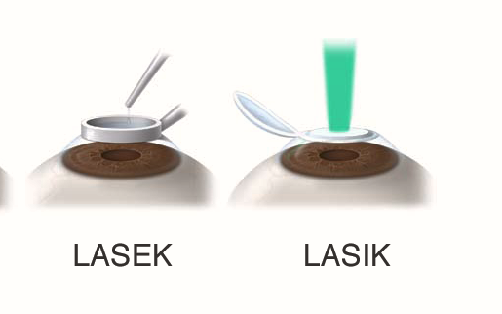Laser eye surgery has transformed the way millions of people correct their vision, reducing or even eliminating the need for glasses or contact lenses. Two of the most popular procedures are LASEK and LASIK—both effective, both FDA-approved, but with important differences. In this guide, we’ll break down the benefits, risks, and recovery times of each procedure to help you decide which option may be right for you.
👁️ What Is LASIK?
LASIK (Laser-Assisted In Situ Keratomileusis) is the most well-known laser eye surgery. It involves creating a thin corneal flap with a laser or microkeratome, reshaping the underlying corneal tissue with an excimer laser, and then replacing the flap.
- ✅ Fast results (vision improves within 24–48 hours)
- ✅ Minimal discomfort
- ✅ Short recovery time
- ❌ Not ideal for patients with thin corneas or dry eyes
- ❌ Flap-related complications possible
👁️ What Is LASEK?
LASEK (Laser-Assisted Sub-Epithelial Keratectomy) is a surface-based procedure. Instead of creating a deep corneal flap, the outer epithelial layer is loosened with alcohol, moved aside, and then replaced after the laser reshapes the cornea.
- ✅ No corneal flap = fewer flap-related risks
- ✅ Better suited for patients with thin or irregular corneas
- ✅ Less risk of dry eye syndrome post-op
- ❌ Longer recovery period
- ❌ More discomfort for a few days post-surgery
🔍 LASEK vs LASIK: Side-by-Side Comparison
| Feature | LASEK | LASIK |
|---|---|---|
| Surgical Technique | Surface reshaping, no corneal flap | Corneal flap created and lifted |
| Ideal For | Thin corneas, dry eyes, contact sport athletes | Most patients with healthy eyes |
| Vision Improvement | Gradual (up to 1–2 weeks) | Rapid (24–48 hours) |
| Post-Op Discomfort | Moderate for several days | Minimal |
| Healing Time | 5–7 days for functional vision, full results in weeks | 1–2 days for functional vision |
| Flap Complications | None (no flap created) | Rare but possible |
| Dry Eye Risk | Lower | Slightly higher |
| Contact Sports Safe? | Yes (no flap to dislodge) | Not recommended without extra caution |
💡 Pros and Cons
✅ LASEK Advantages
- Safe for thin or steep corneas
- No risk of flap complications
- Preferred for physically active patients (martial artists, athletes)
- May be better for those with dry eyes
✅ LASIK Advantages
- Quick visual recovery
- Less pain or discomfort post-op
- Most commonly performed laser eye surgery worldwide
⚠️ Risks to Consider
| Risk | LASEK | LASIK |
|---|---|---|
| Corneal haze | Possible in early recovery | Rare with modern LASIK |
| Night vision issues | Possible in both | Possible in both |
| Dry eye symptoms | Less frequent | More common short-term |
| Infection | Rare in both | Rare in both |
👨⚕️ Which Laser Eye Surgery Is Right for You?
The right procedure depends on several personal and medical factors, including:
- Corneal thickness
- Eye shape and curvature
- Occupation or activity level
- Dry eye history
- Vision goals and lifestyle
A comprehensive eye exam and consultation with an experienced refractive surgeon is essential. They will assess your unique eye anatomy and lifestyle needs to recommend the best option.
✅ Final Thoughts
Both LASEK and LASIK offer life-changing vision correction, but each has distinct advantages. If you’re looking for fast recovery and minimal discomfort, LASIK might be your best bet. But if you have thin corneas, dry eyes, or live an active lifestyle, LASEK could be the safer, more effective choice.




